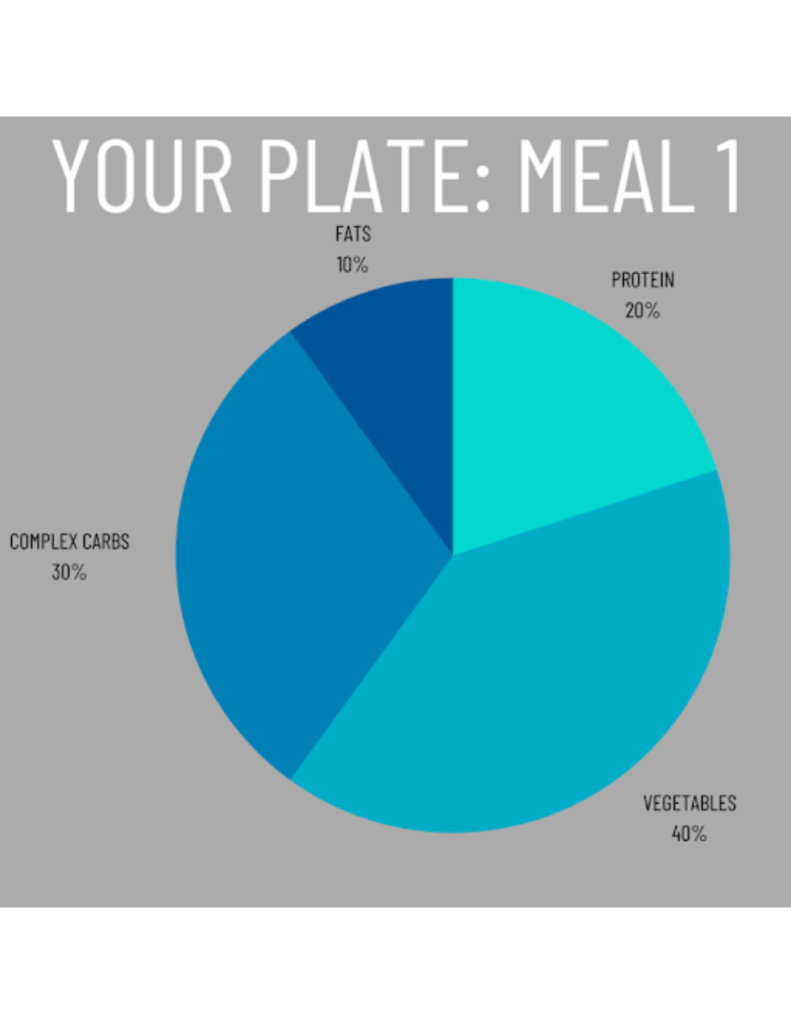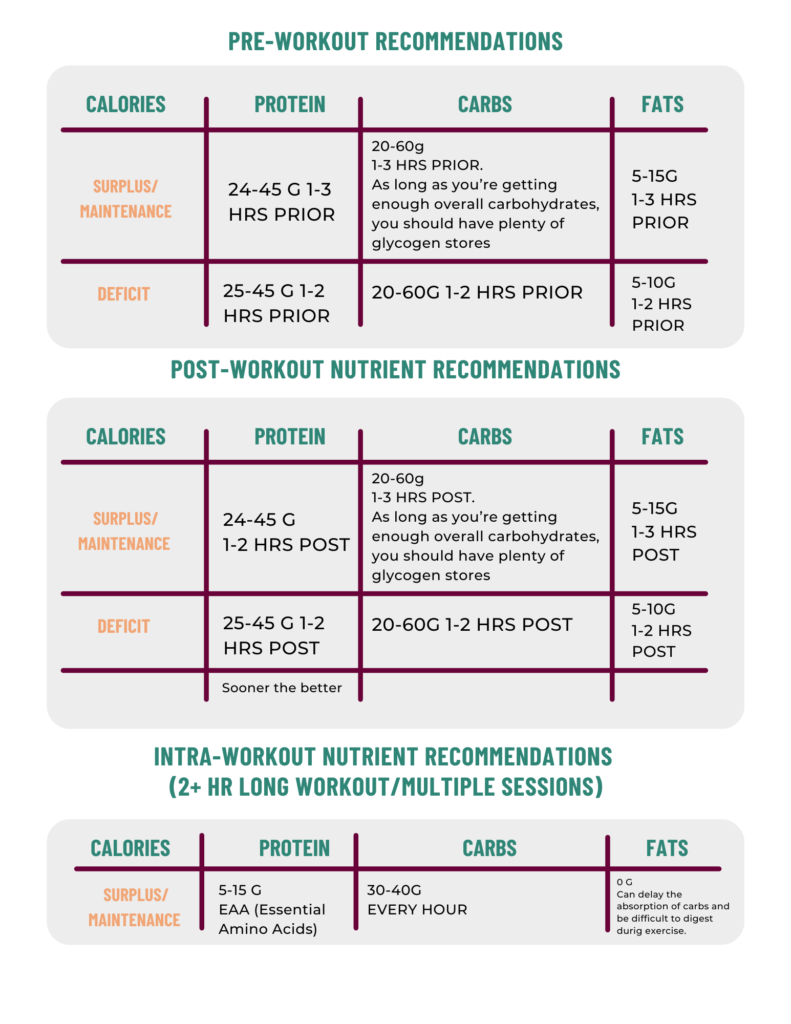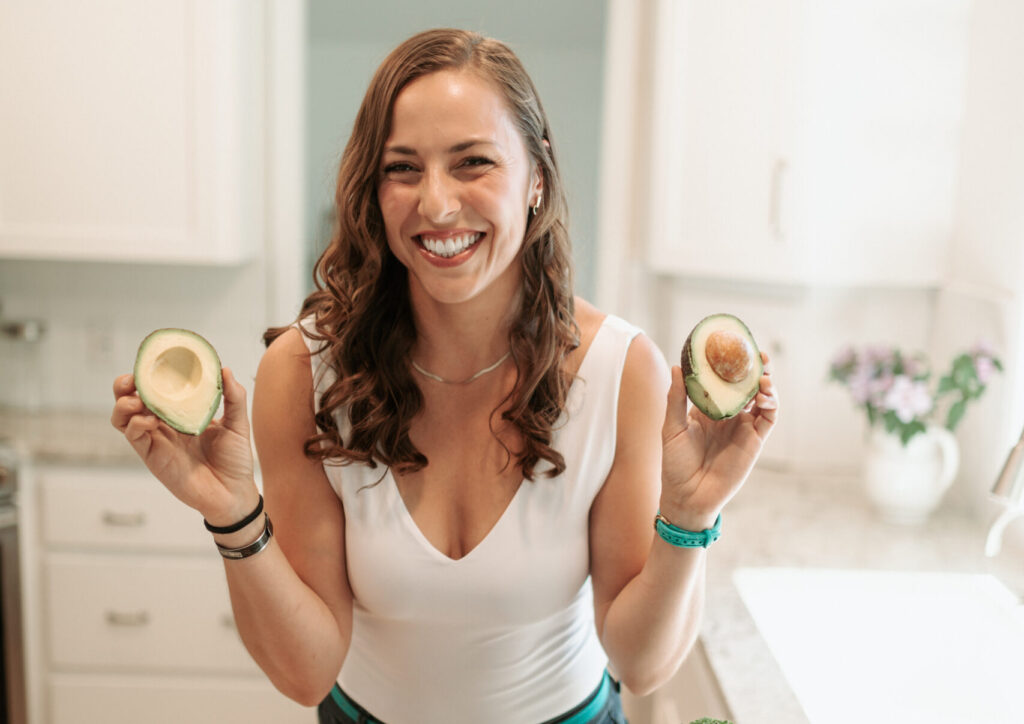GOAL: LOSING FAT
You want to keep as much food as possible while still seeing results. If you’re stuck in a true plateau, not gaining weight, a 10-15% adjustment should be all you need in calories with 80-90% from carbs and 10-20% from fats without going below 20% total calories.
If you’re not seeing the fat loss you want it can mean a lot of different things depending on the person. If there’s no change in the scale, but your body is visually changing, I will suggest you stay put – maybe be more consistent on body measurements vs the scale and focus on how clothes are fitting. If there are no changes anywhere, after a couple of weeks – THEN adjustments can be made. It takes at LEAST two weeks of CONSISTENCY to know if a macro set is or isn’t working. There’s no need to change it each week, it’s too variable.
GOAL: BUILDING MUSCLE
This one is less likely to need much adjustment compared to losing fat, but maybe if you find yourself gaining weight too quickly (see above charts) or not at all over a 3-6 month timeline. That being said, this would also depend on how your physique is changing, how your strength is progressing (or not) along with a host of other factors that really require individual attention. That being said, I still recommend any adjustments from your maintenance (as long as you found true maintenance) be made in 10-15% increments of carbs and fats (assuming your protein is set properly – but may be a factor to consider when trying to build).
BALANCING MEALS

You have an overall calorie goal, but what do you do at each meal?
The simplest way is to divide all macros evenly across the day. Every meal you eat should be somewhat balanced ratio-wise to proteins, fats, and carbs. Again, it doesn’t have to be perfect and this is where the flexibility comes in. If you get more carbs at breakfast, decrease them at dinner. Do you feel like having chocolate? Take away some carbs at lunch. If you think of these categories simply as an exchange system using the tables in APPENDIX A, it doesn’t have to be hard.
At first, I recommend keeping things super simple as they are broken down in the charts. Make foods that you enjoy, but try to find recipes you can create individually like “Honey mustard chicken breast” as opposed to “beefed salmon avant guard rice casserole topped with a drizzle of figgy marinade” (I know this isn’t a thing, but you get my point). Once you get familiar with the individual ingredients you will be better prepared to create more complicated meals without feeling overwhelmed about figuring out what’s in them. MyFitnessPal can help with this using their RECIPE[link video] feature. This can be great especially if you have some recipes that you use on a regular or rotating basis that you can save and easily plugin. It can also be good to use if you have a new recipe that you’re not sure about.
I’m going to break this down for you in a couple of different ways because some people learn differently. We’re going with a balanced and simple concept. Stick with the individual ingredients initially, and go-to recipes later.
YOUR PLATE
Imagine your plate of food split into these categories (found in APPENDIX A) and you’re taking up that much of your plate with those foods. The percentages don’t have to be exact, it’s a general goal.

Here’s another way. Using the lists in APPENDIX A each nutrient is one serving unless otherwise specified.
KEY:
P- PROTEIN
F- FAT
C- CARB (ANY KIND)
CC- COMPLEX CARB
SC- SIMPLE CARB
V- VEGETABLE/FRUIT
MEAL1: P / F / CC / V
MEAL 2: P / F / SC / V
MEAL 3: P / F / CC / V / V
MEAL 4: P / F / V
Let’s dive a little deeper into breaking down a recipe. I’m going to use enchiladas as an example.
According to the title, this is the BEST EVER Enchilada recipe (disclaimer I’ve never made it).
We’re going to break this recipe down by nutrients. If you need to use the lists in APPENDIX A for reference, please do so
8 SERVINGS
Like anything in life, it’s not always black and white. Cheese is fat, but there’s also some protein – it’s fatter than protein so we categorize it into that category, but knowing it can be a source is helpful. Avocados are a vegetable and have great fiber, but they are still largely fat. This is a pretty easy recipe to break down because it’s actually 8 servings so the whole thing can be broken down by that. With each serving, you’d be getting 1 serving of SC, sprinkles of V, small amounts of F depending on your topping usage which is very controllable, and a serving of P. While it could use more vegetables as a meal on its own – if you stuck to 1-2 servings of this and a salad you would hit the above meal planning goals almost perfectly.
SEE APPENDIX A FOR MORE EXAMPLES OF MEAL CREATION
NUTRITION TIMING
Nutrient timing is getting nitty-gritty. If you’re not eating the right things, to begin with, you certainly shouldn’t be worrying about the timing of them. In fact, it can add too much to the equation making it daunting.
My advice for any beginner as far as “timing” goes is: Focus on balanced meals with proteins, fats, and carbs (starchy & vegetable/fruit) Eat a small meal 60-90 mins away from your workout or a bigger one 2-3 hours prior, with a smoothie or small snack closer to if needed. Eat no more than 2 hours post-workout.
The reality is that if you’re getting enough calories and enough protein overall, your performance & recovery will be just fine for the average person.
Studies now show that faster-digesting proteins and carbs are not necessarily beneficial or even absorbed by the body. Whole, minimally processed foods are going to be sufficient. If for convenience’s sake, or just personal preference you prefer a protein shake – that’s fine, but I would recommend it be a smoothie with oats, fruit & peanut butter the shake, not just protein powder itself.
Looking for more advanced methods?
If you are training for endurance races, powerlifting, bodybuilding competitions, or any other athletics that require multiple training sessions per day, or longer than 2 hours at a time – timing becomes more important.
If you’re eating at maintenance or in a surplus, nutrient timing becomes less important than in a deficit because you’re getting sufficient nutrients overall that your body will store for fuel.
If you are in a deficit and running on reserves, looking to maintain performance, and maybe have some aesthetic goals you’re shooting for, your timing of meals around workouts becomes more important, but not necessarily a change in what you should be eating.
The initial suggestions still apply, get your balanced meals but you can apply this tidbit if you need it.
-If exercising for 2 hours or longer or doing multiple training sessions/day, consume intra-workout carbohydrates (30-40g/hr) & protein in the form of EAA’s (5-15g/hr) to help mitigate protein breakdown.


Women’s Functional Nutritionist & Fitness Specialist along with CEO of Elysian Women’s Wellness.
God, family, fitness – in that order. Fitness isn’t my job, it’s my passion. My favorite things include traveling the world, being a mama and making a difference.
14 years of experience in the wellness industry has brought me to an understanding that when you’re ready – you’ll do it. So when you are, we’re here to keep you simply well.
The last “program” you’ll ever buy. Your individualized training & nutrition plan that teaches the why & how to create lasting changes with me by your side every step of the way!

Error: No feed found.
Please go to the Instagram Feed settings page to create a feed.
Level 0, 1, 2 & 3: Level Up your workouts with beginner to advanced plans designed with a focus lift each month, progressive overload, instructional videos & all inclusive training & nutrition guides.
Copyright ©2024. Gamechanger
A BRANDT CREATIVE CO. TEMPLATE. Trusted by Wimgo.